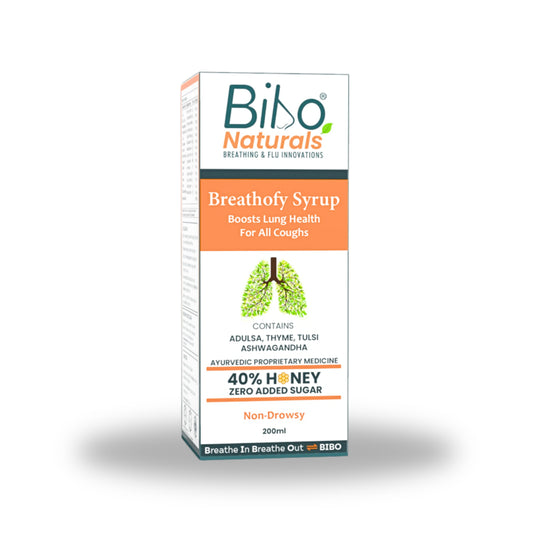Nearly 300 million people worldwide are suffering from asthma, out of which 6% of the cases are seen in children while 2% contribute to adult asthma. The prevalence of asthma increases by 50% every passing decade. Nearly 2/3rd of asthma cases are diagnosed before the age of 18 years. In India, nearly 30 million people are asthmatic. Every year about 4.5 lakh people die from asthma worldwide, with a mortality rate of 2 lakh in India.
What is Asthma?
Asthma (also termed bronchial asthma) is an inflammatory condition of the smooth muscles lining the airways. It is a chronic condition affecting all age groups, especially children and young adults.
Pathophysiology of Asthma
Asthma is mainly characterized by varying degrees of airflow obstruction (related to swelling, bronchospasm and hyper-secretion) and airway inflammation. In asthma, all the cells of the airways get activated, such as epithelial cells, eosinophils, T cells, mast cells, macrophages, fibroblasts and bronchial smooth muscle cells.
The inflammatory reaction can be divided into two phases: early and late-phase.
On exposure to allergens, the body releases and activates various cells containing allergen-specific IgE (antibodies specific to allergens), such as mast cells and macrophages. These cells release pro-inflammatory mediators (chemicals) like histamine, eicosanoids, and reactive oxygen species that cause airway smooth muscle contraction, mucus secretion and dilatation of the blood vessels. This is termed the early-phase inflammatory reaction.
The late-phase inflammatory reaction occurs after a few hours (about 6-9 hours) of allergen exposure. In this phase, the body activates other inflammatory cells such as eosinophils, CD4+ T cells, basophils, neutrophils, and macrophages. This is commonly seen in chronic asthma.
Classification of asthma
1. Based on the severity
Intermittent: The symptoms are mild and don't interfere with sleep and daily activities. The symptoms will occur less than twice a week. On examination, the lung function is normal. The chances of an asthma attack are very less.
Persistent
- Mild: The symptoms may occur more than twice a week but not daily. It may slightly interfere with sleep (3-4 times a month) and daily activities. On examination, the lung function is normal. An asthma attack can occur more than twice a year (in children, it can be more than twice in six months or four or more episodes of wheezing in a year that lasts for more than one day).
- Moderate: In moderate persistent asthma, the symptoms occur daily with nighttime waking up to 3-4 times a month (or more than once a week). It may cause some limitations in daily activities. On examination, there may be a slight reduction in lung function (up to a 5% reduction). The occurrence of asthma attacks is similar to that of mild persistent asthma.
- Severe: In severe persistent asthma, the symptoms of asthma occur throughout the day, with nighttime waking seen often every day. The daily activities are extremely limited, and on examination, the lung function is reduced by more than 5%. Similar to mild persistent asthma, asthma attacks can occur more than twice a year.
2. Based on triggering factors
Allergic asthma: Asthma can be triggered by various allergens such as pollen, dust, animal fur, some chemicals, paints, certain medicines, cold air, some foods, etc.- Temporary asthma: Some people may or may not have asthma, but when exposed to allergens, they show asthma-like symptoms.
- Seasonal: In some people, the asthma symptoms flare up only during a particular season, especially during the rainy and winter seasons (when there is an increase in pollens and during cold). People with seasonal asthma may also have other related conditions like hay fever (seasonal allergies).
- Occupational: people who work at chemical factories, bakeries, agricultural fields, spice and food factories, printing presses, plastic, rubber and wood factories and other places where there is a lot of smoke and dust are prone to develop asthma. These people show asthma flare-ups when exposed to such occupational allergens.
- Exercise-induced asthma (bronchospasm): Some people may not have asthma but may show asthma-like symptoms, such as wheezing and breathlessness only after exercise. It is common in a dry and cold climate.
- Medicines: Some medicine such as aspirin and other NSAIDs (Non-steroidal anti-inflammatory drugs), benzalkonium chloride (preservative), and beta-blockers (ex: propranolol, labetalol, carvedilol, etc.)
- Respiratory tract infections: The common respiratory tract infections such as common cold, pharyngitis, sinusitis, and bronchitis may contribute to asthma-like symptoms or may even trigger the symptoms of asthma.
3. Based on age
Adult onset asthma: It is also termed late-onset asthma. Generally, people develop asthma in early childhood, but some people may show the symptoms in adulthood (above 18 years of age).- Occupational: As discussed above, occupational asthma occurs due to exposure to allergens based on occupation.
- Smoking
- Stress
What is extrinsic and intrinsic asthma?
Extrinsic asthma
It is also termed allergic asthma. It will be caused by an allergic reaction provoked by allergens such as pollen, dust, some food, etc., a blood test shows an increased level of IgE antibodies (antibodies specific to allergens)
Intrinsic asthma
Intrinsic asthma is triggered by non-allergens such as cold and dry air, smoke, respiratory tract infection, stress, emotional status (anxiety, laughter, or crying may provoke asthma) and more.
Causes of Asthma
The exact cause of asthma is unclear. However, several factors may play an important role in developing asthma, including environmental and genetic factors such as a family history of asthma, socioeconomic status, tobacco smoke, allergens, urbanization, pollution and respiratory infections.
- Genetics
- Poor immunity and infections
- Allergies
- Irritants
- Air pollution
- Smoking
- Narrow airways
- Hormones
Triggering Factors for Asthma
People with asthma may not have the symptoms all the time. Some triggering factors may lead to their symptoms or exacerbations.
The most common ones include-
- Exposure to allergens such as grass, plants, house dust, cockroaches, pollen grains, animal fur
- Cold air
- Tobacco smoking
- Wood smoke
- Emotional state (anxiety, stress, laugh)
- Exercise or physical activity: Some people show asthma-like symptoms such as cough, wheezing, breathlessness or chest tightness only after being exposed to strenuous (vigorous) exercise. This is also termed exercise-induced bronchospasm. However, exercise will not cause asthma.
- Certain drugs (particularly aspirin and other NSAIDs)
- Occupational status of a person: Bakers, farmers, printers, painters, plastics, rubber, and woodworkers, people working in chemical factories are more prone to asthma.
Symptoms of Asthma
The most common symptoms of asthma are-
- Cough
- Wheezing
- Chest tightness
- Shortness of breath
- Breathing difficulty
Usually these symptoms are worsened at nighttime or when a person suffering from asthma comes in contact with a triggering factor.
People with acute severe asthma attacks may also have
- Severe dyspnea (shortness of breath)
- Burning sensation in the chest
- Increased heart rate
- Rapid or fast breathing
- Pale skin
- Seizures (in severe cases)
Diagnosis of Asthma
Generally the diagnosis of asthma is based on the symptoms and physical examination. However, many tests are done to check how well the lungs are functioning and the effectiveness of asthma medicines.
Pulmonary Function Test (PFT)There are several tests that can tell how well your lungs are functioning. Some of the most common ones include:
- Spirometry
A spirometer is a device that measures the volume of air inspired and expired by the lungs and the time taken to exhale completely after a deep breath. In other terms it measures the capacity and amount of air that passes in and out of the lungs. The procedure is termed as spirometry.
It is the main test used to diagnose asthma in people 5 years or older.
Procedure:
To know the performance of your lungs (pulmonary function), you have to take a deep breath and breath out forcefully into the connected tube of the spirometer.It records the amount of air you exhale and how quickly you do it.
- Challenge test
Methacholine or Bronchoprovocation test: In this test, a person will be asked to inhale increasing doses of a medicine (methacholine) that may causes airways to narrow.
Treadmill test: This test is done to find out if a person experience asthma-like symptoms while doing exercise or physical activity.
Lung tests in children
Doctors rarely perform lung tests in children under age 5. Mostly, diagnosis is based on signs and symptoms, medical history, and physical examination.
Exhaled nitric oxide testIn this test, a person is asked to breathe into a tube connected to a machine that takes the measurement of the nitric oxide amount present in the breath. Nitric oxide gas is normally produced in the body. But if it is found in high amounts, that is an indication of having asthma.
X-ray or computerized tomography (CT) imaging of the chest.
Blood test
Gastroesophageal reflux assessment
Sputum eosinophil: Eosinophils are a type of white blood cell which is generally increased in asthma.
Allergy test:
Allergy tests diagnose an allergic reaction, such as hay fever, that may cause asthma symptoms or worsen existing asthma. Many people with asthma may be allergic to something that may trigger their symptoms.
Treatment
Asthma medicines are generally given in pills, syrups, inhalers or nebulizers. The most common medicines prescribed for asthma are-
Bronchodilators:
These medicines help to relax the bronchial tubes and keep the airways open. They are of 3 types-
- Β2 agonists
Short-acting: These medicines generally show instant relief but acts but a shorter duration (2-4hours). The rescue inhalers contain these medicines.
Example: Salbutamol, Albuterol
Long acting: These medicines provide a long-term benefit for asthma patients. They are generally taken with corticosteroids.
Example: Salmeterol, formoterol
- Anticholinergics
Example: Ipratropium bromide, tiotropium
- Theophylline:
Steroids:
These medicines help to reduce inflammation and prevent the asthma flare-ups.
Examples: budesonide, beclomethosone.
Mucolytic:
These medicines help to thin the mucus in the airways so it is easily removed from the airways when someone coughs. In asthma, when the airways gets inflamed and narrowed, mucus is secreted which may further block the airways making it more difficult to breathe. Thus, mucolytic agents help to break the thick mucus, so that there is enough space in the airways for air to pass. These medicines are generally combined with other medicines like bronchodilators and given in the form of syrups.
Example: Acetylcysteine, ambroxol, bromhexine.
Biologics:
Biologics are initiated when all the other treatment options fail. These agents target specific inflammatory pathways that are involved in the development of asthma. These medicines are generally taken as a shot or in injection form (IV infusion).
Biologics include a class of medicines called as monoclonal antibodies which are blood proteins synthesized artificially.
Example: omalizumab, dupilumab.
Home Remedies for Asthma
- Elevate the head of the bed by about 4 inches. It may help to keep the airways open while sleeping.
- Taking a steam inhalation before sleeping may help to keep the airways open. You can also add a few drops of peppermint oil to it, as it may help to reduce the feeling of shortness of breath (dyspnea).
- Sleep on your side.
- Take a teaspoonful of honey before bedtime, it helps to reduce cough and provide a soothing effect on throat.
- Drink warm fluids like herbal tea, soups or warm water.
- Eat healthy. Include vitamin C-rich foods to improve your immunity.
- Foods rich in magnesium may help to reduce inflammation and help open up the airways for easy breathing. Pumpkin seeds, spinach, cashews, cereals, milk, dark chocolate, almonds, raisins, avocado, whole wheat, salmon, soymilk, peanut butter, brown rice, potato, yoghurt and banana are rich in magnesium.
- Perform mild exercises, walks and breathing exercises to improve the lung function.
References:
- National Asthma Education and Prevention Program, Third Expert Panel on the Diagnosis and Management of Asthma. Expert Panel Report 3: Guidelines for the Diagnosis and Management of Asthma. Bethesda (MD): National Heart, Lung, and Blood Institute (US); 2007 Aug. Section 2, Definition, Pathophysiology and Pathogenesis of Asthma, and Natural History of Asthma.
- Quirt, J., Hildebrand, K.J., Mazza, J. et al. Asthma. Allergy Asthma Clin Immunol 14, 50 (2018).
- Quirt J, Hildebrand KJ, Mazza J, Noya F, Kim H. Asthma. Allergy Asthma Clin Immunol. 2018 Sep 12;14(Suppl 2):50.
- Louie S, Zeki AA, Schivo M, Chan AL, Yoneda KY, Avdalovic M, Morrissey BM, Albertson TE. The asthma-chronic obstructive pulmonary disease overlap syndrome: pharmacotherapeutic considerations. Expert Rev Clin Pharmacol. 2013 Mar;6(2):197-219.




